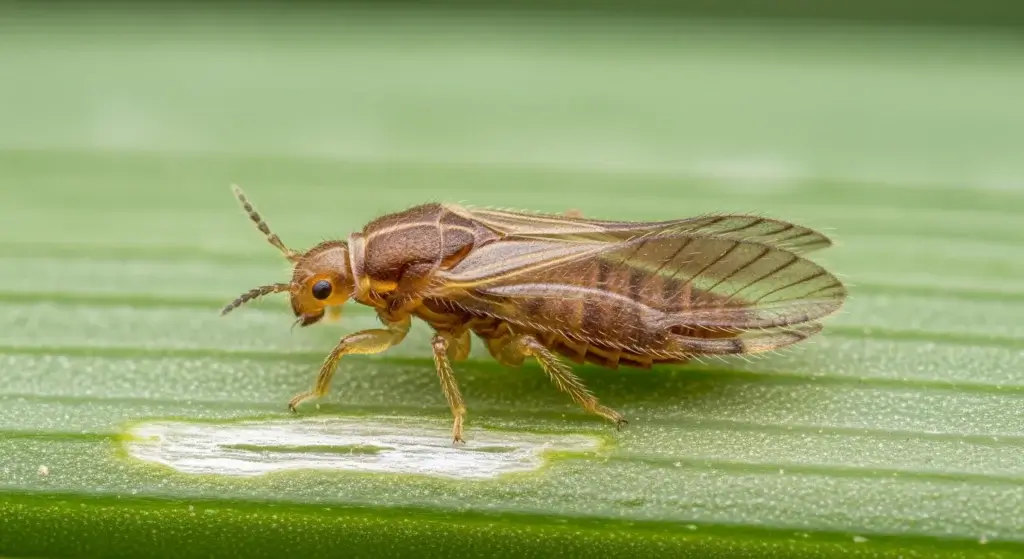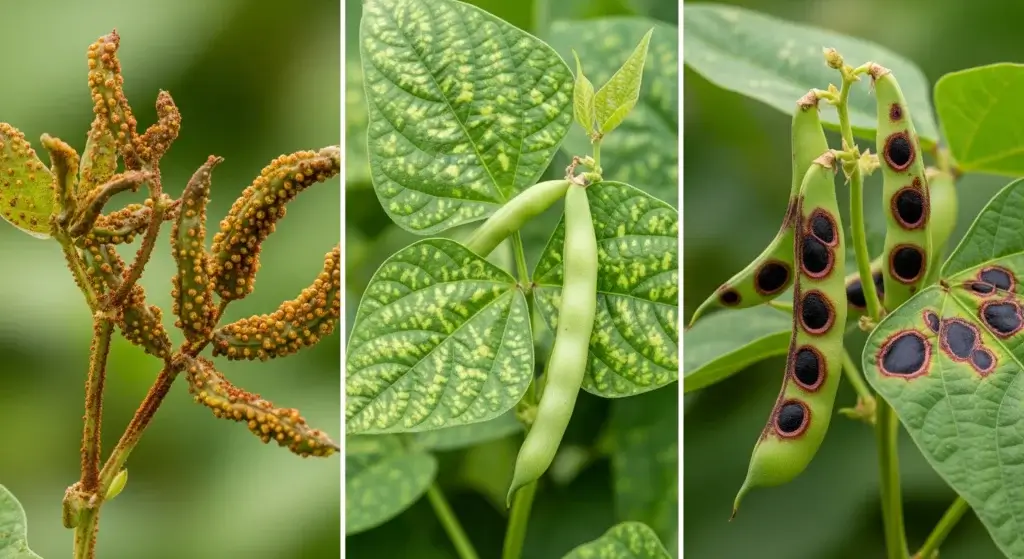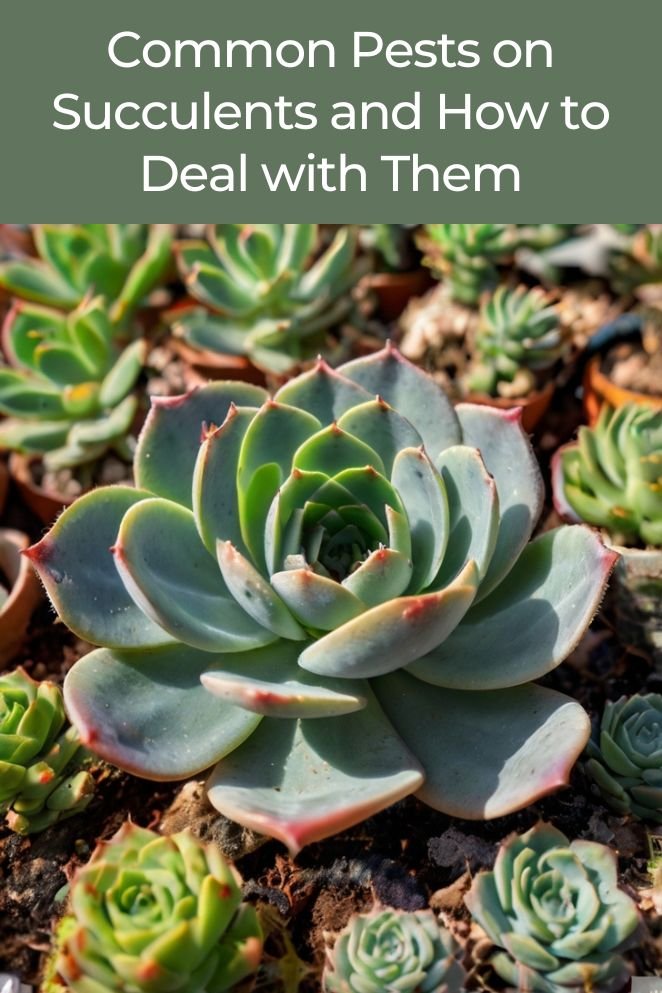
Succulents, with their unique shapes and vibrant colors, have become beloved houseplants.
However, even these hardy plants are not immune to pests.
Common pests can wreak havoc on succulents, hindering their growth and potentially even killing them.
Understanding these pests and their behaviors is crucial for effective prevention and treatment.
Let’s explore the most common pests that target succulents and provide practical tips on how to identify, prevent, and eradicate them.
Common Succulent Pests and Treatment
Mealybugs
Mealybugs are one of the most common pests found on succulents.
They appear as small, white, cotton-like masses on the leaves and stems of your plants.
Mealybugs are often found in clusters, resembling tiny balls of cotton.
They tend to hide in the crevices, joints, and under the leaves of plants.
As mealybugs feed, they deprive the plant of essential nutrients, hindering its growth.
The loss of sap can cause leaves to turn yellow and become weak.
Mealybugs secrete a sticky substance called honeydew, which can attract sooty mold and ants.
Treatment
- Manual removal: If you spot a few mealybugs, remove them manually with a cotton swab dipped in rubbing alcohol. The alcohol will kill the bugs on contact.
- Insecticidal soap: For larger infestations, spray the plant with insecticidal soap, which is effective in killing mealybugs without harming the plant.
- Systemic insecticide: In severe cases, a systemic insecticide may be necessary. This type of insecticide is absorbed by the plant and kills pests as they feed on the sap.
Aphids
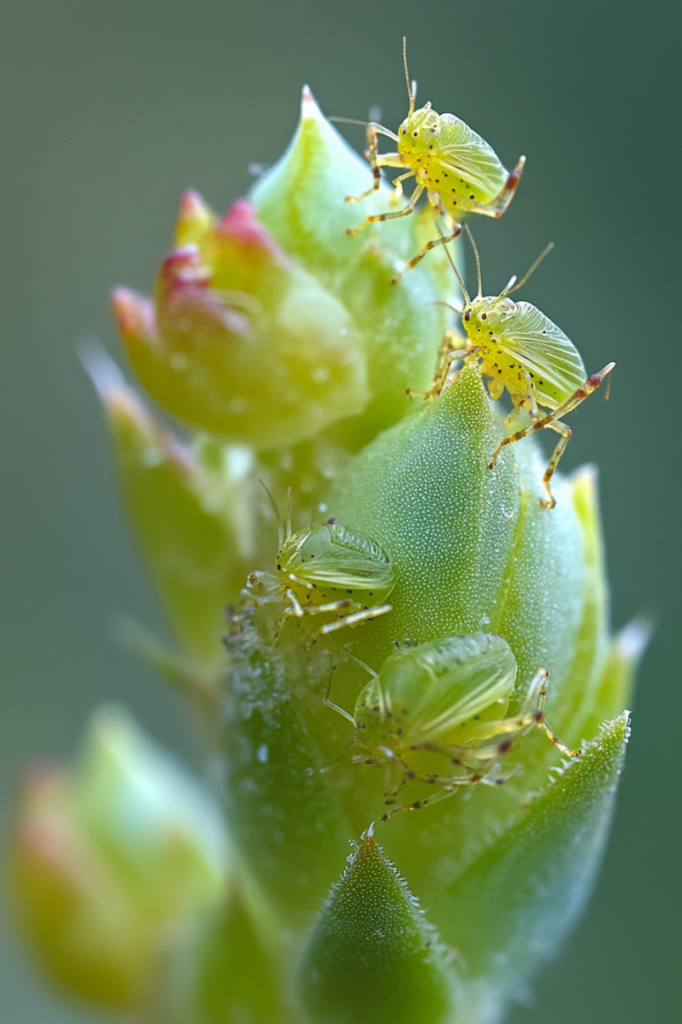
Aphids are small, pear-shaped insects.
They are typically pale green, but they can also be yellow, black, or even pink.
Most species are wingless and crawl slowly over plants, while some may develop wings if the infestation becomes too dense, allowing them to fly away and find new food sources.
They often form large colonies on the stems, leaves, and buds of plants.
Aphids use their piercing mouthparts to poke holes in plants and suck out the sap.
This feeding behavior can cause individual plants to become shriveled and stunted, especially if the infestation is heavy.
Aphids leave behind a sticky residue known as honeydew.
This substance can attract mold and other pests, and it may also sour and develop into a fungal infection known as sooty mold, which blocks light and obstructs photosynthesis.
Treatment
- Physical removal: Use a cotton swab dipped in rubbing alcohol to wipe aphids off the plant. Repeat this process until the infestation is eradicated
- Water spray: A strong blast of water can dislodge aphids from your succulents. This method works well for minor infestations.
- Neem oil: Neem oil is a natural insecticide that works by suffocating the aphids. Spray neem oil on the affected areas and repeat as necessary.
- Beneficial insects: Introducing beneficial insects like ladybugs, which are natural predators of aphids, can help control the population.
Spider mites
Spider mites are arachnids, closely related to spiders and ticks.
They belong to the Acari family, with over 1,600 identified species, the most common being the two-spotted spider mite.
Spider mites can infest a wide variety of plants, including succulents, trees, and houseplants.
Spider mites are extremely small, typically about 1/50 inch (1.25 millimeters) in length, often difficult to see with the naked eye.
They come in various colors, including green, orange, red, and yellow, depending on their age and species.
They have two body segments and eight legs, with piercing-sucking mouthparts that allow them to feed on plant sap.
They spin fine webs on the undersides of leaves and cause the foliage to turn yellow and drop prematurely.
Treatment
- Isolation: If you suspect a spider mite infestation, isolate the affected plant immediately to prevent the mites from spreading.
- Insecticidal soap: Spray the plant with insecticidal soap, focusing on the undersides of the leaves where spider mites tend to hide.
- Dormant oil: Applying dormant oil during winter or spring can help remove eggs that may have settled on plants.
- Natural predators: Attracting natural predators like lacewings and predatory mites can help control spider mite populations
- Miticides: For severe infestations, consider using a miticide, which is specifically formulated to target spider mites.
Scale insects
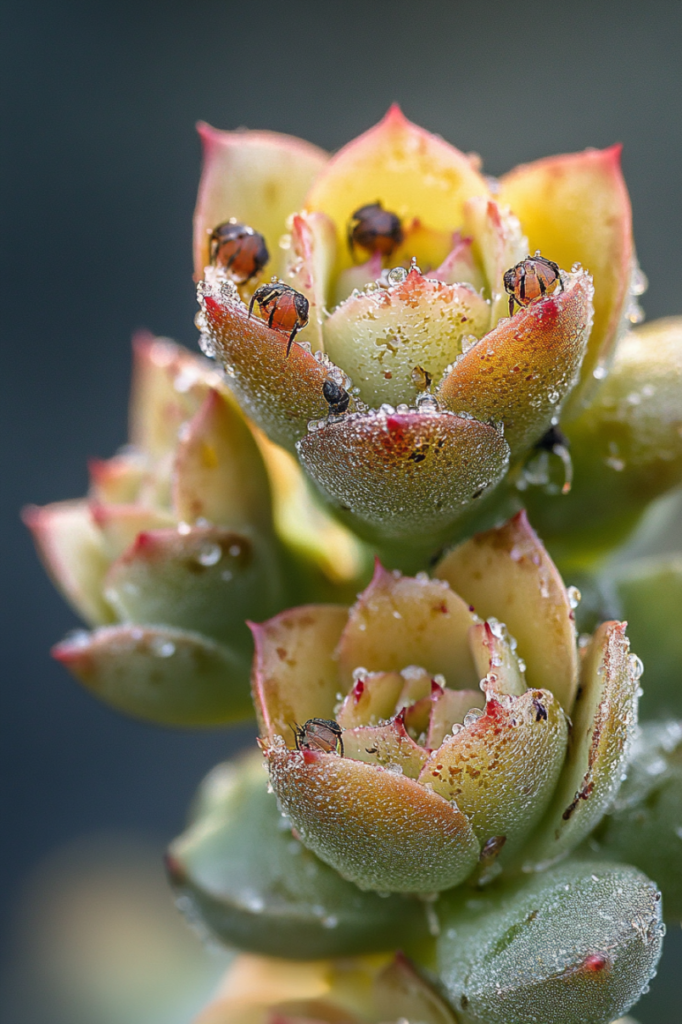
Scale insects are tiny, hard-bodied pests that can infest succulents.
They appear as small, round or oval bumps on the stems and leaves, often blending in with the plant’s natural appearance.
These pests are protected by a hard, protective covering, similar to a small shell or scale, which is where they get their name.
Scale insects feed by sucking sap from the plant, causing leaves to yellow and wilt.
They are firmly attached to the plant tissue and removing them often leaves behind a small scar.
The life cycle of a scale insect includes several stages, starting with eggs and then moving to a mobile crawler stage before settling and forming a protective covering.
Adult scale insects are typically immobile, remaining attached to the plant.
If you notice small, round bumps on your succulent, it’s possible you have a scale insect infestation.
Taking prompt action is essential to prevent further damage to your plant.
Treatment
- Manual removal: Gently scrape off the scale insects with a toothbrush or your fingernail. Be careful not to damage the plant.
- Horticultural oil: Apply horticultural oil to suffocate the insects. This method is effective and safe for the plant.
- Systemic insecticide: In persistent cases, a systemic insecticide can help eliminate the infestation from within.
Whiteflies
Whiteflies are small, winged insects that can infest a variety of plants, including succulents.
They are about the size of a pinhead and have four powdery white wings.
Their bodies are usually yellow or orange, but they appear white due to a waxy coating.
Whiteflies feed on plant sap, which can cause leaves to yellow and drop.
The first sign of a whitefly infestation is often small white insects flying up when you touch the plant leaves.
Infested leaves may also have small white or yellow spots, a bronze or brownish color, and fine, silken threads.
Whiteflies secrete a sticky substance called honeydew, which can attract other pests and cause sooty mold to develop on the plant.
If you notice any of these signs on your succulent, it’s important to take action to control the infestation.
Treatment
- Manual removal: If you notice a few whiteflies on your succulent, try shaking the plant gently to dislodge them. You can also use a handheld vacuum to remove them. Be sure to empty the vacuum far away from your plants to prevent re-infestation.
- Yellow sticky traps: Whiteflies are attracted to the color yellow. Placing yellow sticky traps around your succulents can help capture adult whiteflies and reduce their population.
- Insecticidal soap: Spraying your succulents with insecticidal soap can effectively kill whiteflies. Make sure to thoroughly coat the undersides of the leaves, where whiteflies tend to hide. Repeat the treatment every few days until the infestation is under control.
- Neem oil: Neem oil is a natural insecticide that works well against whiteflies. Mix neem oil with water and a few drops of dish soap, and spray it on the affected plants. Neem oil disrupts the whiteflies’ life cycle, preventing them from reproducing.
- Biological control: Introducing natural predators like ladybugs or lacewings to your garden can help control whitefly populations. These beneficial insects feed on whiteflies and can help keep their numbers in check.
Fungus gnats
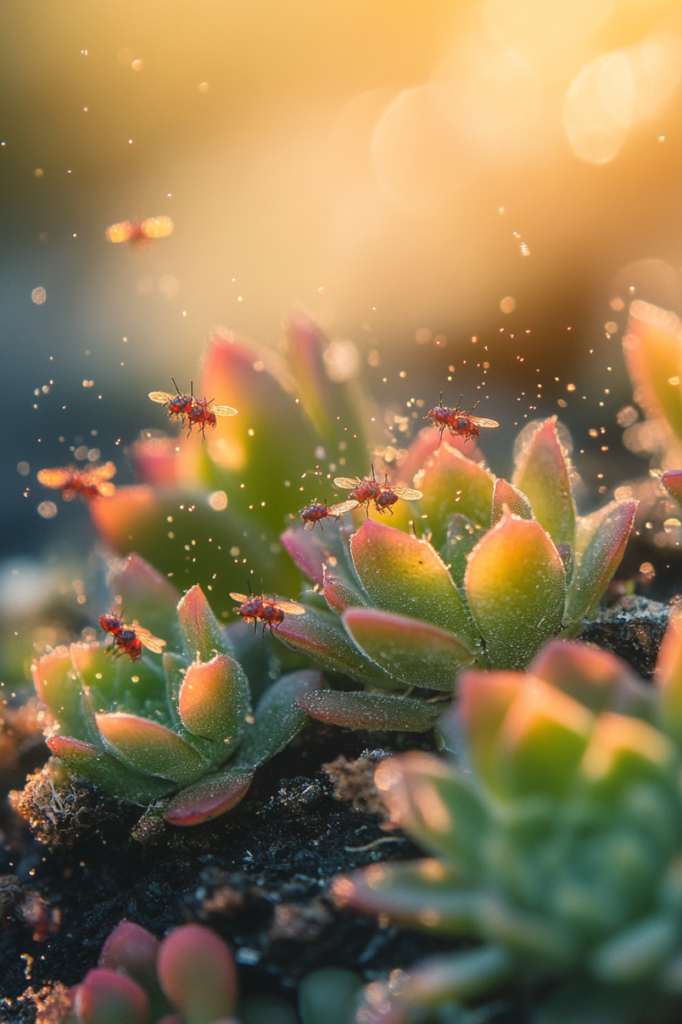
Fungus gnats are tiny, delicate-looking flies that fall under the family Sciaridae.
These pests are quite common in greenhouses, nurseries, and indoor plant setups, especially where moisture is prevalent.
They typically vary in color, ranging from gray to black, and are recognizable by their slender legs and segmented antennae, which are notably longer than their heads. This feature sets them apart from shore flies, which have short, bristle-like antennae.
Another distinctive characteristic of fungus gnats is the Y-shaped vein found on their wings.
The larvae of fungus gnats mainly feed on fungi and organic matter found in soil.
However, they can also chew on plant roots, leading to various issues like poor growth, yellowing leaves, and stunted development.
One of the significant concerns with these larvae is their potential to spread plant pathogens such as Pythium, which can cause damping-off and root rot.
While the adult fungus gnats are harmless—they don’t bite humans or animals—they can still be quite a nuisance.
They tend to fly around people’s faces and can be attracted to moisture, feeding on mucus near the eyes, ears, and other areas.
The larvae are particularly problematic for seedlings and young plants, as their root-chewing can cause severe damage, leading to stunted growth or even plant death if not properly managed.
Additionally, the presence of fungus gnats can make plants more vulnerable to infections like collar rot, root rot, and damping-off by spreading harmful pathogens.
Treatment
- Soil management: Fungus gnats thrive in moist soil. Allow the soil to dry out between waterings to discourage them.
- Sticky traps: Place yellow sticky traps near your succulents to catch adult gnats.
- Hydrogen peroxide solution: Mix one part hydrogen peroxide with four parts water and use it to water your succulents. This will kill the larvae in the soil without harming the plant.
- Beneficial nematodes: Introduce beneficial nematodes to the soil to prey on fungus gnat larvae.
Ants
Ants are not usually harmful to succulents themselves, but their presence can indicate a more significant problem.
Ants are often attracted to succulents because they feed on the honeydew produced by other pests like aphids, mealybugs, and whiteflies.
This sticky substance is a sugary byproduct of these pests feeding on the plant’s sap.
In some cases, ants even protect these pests from predators to ensure a steady supply of honeydew.
If you notice ants around your succulents, it’s a sign that you may have an underlying pest problem that needs addressing.
Treatment
- Identify other pests: Since ants are typically drawn to the honeydew produced by pests like aphids or mealybugs, the first step is to inspect your succulents for these insects. Treating these pests will often reduce or eliminate the ant problem.
- Use ant baits: Ant baits can be an effective way to eliminate an ant infestation. Place ant bait stations near the affected plants, but not directly on the soil, as this could introduce harmful chemicals to your succulent. The ants will carry the bait back to their nest, effectively reducing the population.
- Create a barrier: To prevent ants from accessing your succulents, create a barrier around the plants. You can use diatomaceous earth, a natural, non-toxic powder that is abrasive to ants, or draw a line of chalk or talcum powder around the plant’s pot.
- Natural repellents: Spraying a solution of vinegar and water around your succulent pots can help repel ants. Ants dislike the strong scent of vinegar and will avoid areas treated with it. Essential oils like peppermint, cinnamon, or citrus oils can also be effective as natural repellents. Mix a few drops with water and spray around your plants.
- Keep the area clean: Ants are attracted to food sources, so keeping the area around your succulents clean is essential. Remove any fallen leaves, debris, or other organic matter that might attract ants.
Conclusion
Succulents are generally hardy plants, but they are not immune to pests.
Regular inspections and quick action can keep your succulents healthy and looking their best.
By identifying pests and using the right treatments, you can manage common problems and enjoy your plants for years to come.
FAQs
It’s a good idea to inspect your succulents at least once a week. This allows you to catch any potential pest problems early before they become severe.
To prevent pest infestations, ensure your succulents are healthy by providing proper light, water, and soil conditions. Avoid overwatering, and keep your plants clean by removing dead leaves and debris.


